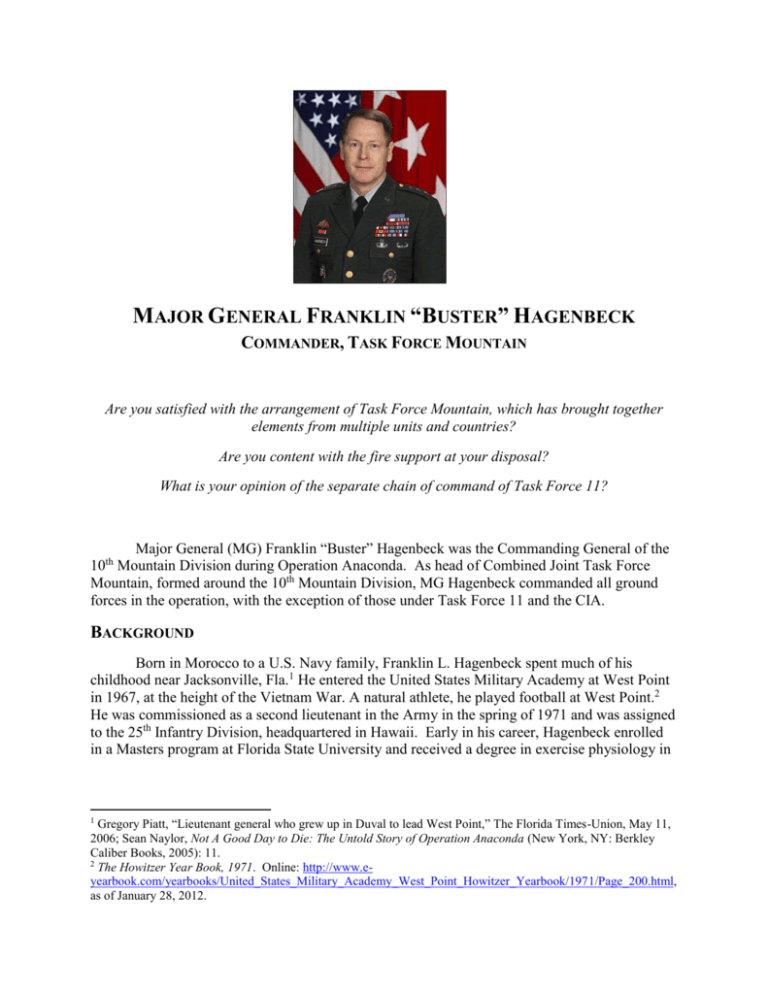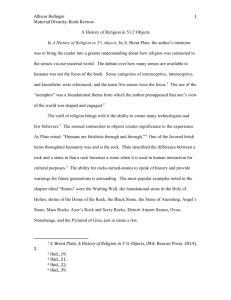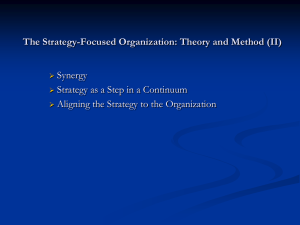Backgrounder
advertisement

MAJOR GENERAL FRANKLIN “BUSTER” HAGENBECK COMMANDER, TASK FORCE MOUNTAIN Are you satisfied with the arrangement of Task Force Mountain, which has brought together elements from multiple units and countries? Are you content with the fire support at your disposal? What is your opinion of the separate chain of command of Task Force 11? Major General (MG) Franklin “Buster” Hagenbeck was the Commanding General of the 10th Mountain Division during Operation Anaconda. As head of Combined Joint Task Force Mountain, formed around the 10th Mountain Division, MG Hagenbeck commanded all ground forces in the operation, with the exception of those under Task Force 11 and the CIA. BACKGROUND Born in Morocco to a U.S. Navy family, Franklin L. Hagenbeck spent much of his childhood near Jacksonville, Fla.1 He entered the United States Military Academy at West Point in 1967, at the height of the Vietnam War. A natural athlete, he played football at West Point.2 He was commissioned as a second lieutenant in the Army in the spring of 1971 and was assigned to the 25th Infantry Division, headquartered in Hawaii. Early in his career, Hagenbeck enrolled in a Masters program at Florida State University and received a degree in exercise physiology in Gregory Piatt, “Lieutenant general who grew up in Duval to lead West Point,” The Florida Times-Union, May 11, 2006; Sean Naylor, Not A Good Day to Die: The Untold Story of Operation Anaconda (New York, NY: Berkley Caliber Books, 2005): 11. 2 The Howitzer Year Book, 1971. Online: http://www.eyearbook.com/yearbooks/United_States_Military_Academy_West_Point_Howitzer_Yearbook/1971/Page_200.html, as of January 28, 2012. 1 1978.3 Not surprisingly, given his athleticism and love of sports, he also served as an assistant coach for the Seminoles football team during his graduate study.4 Over three decades, Hagenbeck held command at every level, from company to division. Serving in the 25th Infantry Division, the 82nd Airborne Division, the 101st Airborne Division, and the 10th Mountain Division, he became a part of the Army’s airborne and light infantry community—and his personal connections would serve him well in Afghanistan. He also held a variety of staff positions during his military career, including two on the Joint Staff, first as the Deputy Director for Politico-Military Affairs in the Strategic Plans and Policy Directorate and later as the Deputy Director for Current Operations.5 His Washington service made him known and trusted among senior Pentagon leaders. Hagenbeck’s combat experience was limited to his time with the 82nd Airborne Division in Grenada in 1983.6 OPERATION ENDURING FREEDOM In the fall of 2001, Hagenbeck assumed command of the 10th Mountain Division, headquartered in snowy Fort Drum, NY. The course of his tenure with the 10th Mountain changed dramatically after September 11, 2001, and the initiation of Operation Enduring Freedom—the campaign to destroy al Qaeda and topple the Taliban in Afghanistan— on October 7, 2001. In November 2001, the 10th Mountain Division headquarters deployed to Karshi-Khanabad, Uzbekistan. In Karshi-Khanabad, Hagenbeck would command the “forward” headquarters—the headquarters closest to the ongoing campaign in Afghanistan— for all U.S. and allied land units. Hagenbeck would answer to Lieutenant General Paul Mikolashek, commander of the land forces in the U.S. Central Command (CENTCOM) area, who had also relocated his headquarters from Fort McPherson, Ga., to Camp Doha, Kuwait, to get closer to the action. Mikolashek in turn reported to General Tommy Franks, CENTCOM’s overall commander. Franks remained in CENTCOM headquarters in Tampa Bay, Fla. (For an overview of command arrangements, see attached, “Chain of Command”) At Karshi-Khanabad, Hagenbeck stood ready to provide the first conventional forces for Operation Enduring Freedom in Afghanistan.7 But he faced significant hurdles. Army officials had selected his 10th Mountain to establish forward headquarters even though it was the most undermanned, stressed, and stretched division headquarters in the Army, with significant manpower already deployed elsewhere.8 The 101st Airborne Division, with no ongoing deployments and the prized ability to conduct helicopter air assaults, would have been a more natural and appropriate choice to deploy as the forward headquarters. But most of the 101st Airborne was being held in reserve for possible operations in Iraq, leaving the 10th Mountain Division to deploy to Uzbekistan.9 And CENTCOM placed stringent restrictions on the 10th Gregory Piatt, “Lieutenant general who grew up in Duval to lead West Point.” Gregory Piatt, “Lieutenant general who grew up in Duval to lead West Point.” 5 Official Biography, United States Military Academy at West Point. 6 Naylor, Not a Good Day to Die, 11. 7 Ibid., 11. 8 Ibid., 86. 9 Naylor, Not a Good Day to Die, 84-85. 3 4 Mountain headquarters, stating that only 50 to 60 troops were needed for the deployment.10 Knowing that a force this size was not enough to maintain a 24-hour operational tempo, Hagenbeck negotiated a higher cap of 160 soldiers.11 Troops from the XVIII Airborne Corps and Forces Command augmented the staff, particularly the intelligence section.12 When the 10th Mountain Division headquarters arrived in Uzbekistan on December 1, more than a third of its soldiers were strangers to Hagenbeck. But even though much of “Task Force Mountain” came from disparate units, many of the officers and non-commissioned officers had served together in the past. Hagenbeck’s first weeks in Uzbekistan did not turn out as planned. While northern Afghanistan had fallen more quickly than expected to the Northern Alliance—a collection of hardened Afghan militias long opposed to Taliban rule— and U.S. Special Forces, conventional forces stood by to participate in what most believed would be a long fight for Kabul and southern Afghanistan. These areas also fell quickly, and by late December Hagenbeck again found himself on the sidelines of a war that appeared to be largely over. As he later recalled, he was “chomping at the bit to do something.”13 Increasingly frustrated at not getting to participate in combat in Afghanistan, Hagenbeck ordered his staff to draw up concepts of operations that would allow his unit to join the fight. Major Paul Wille, the division’s chief of plans, and Captain Francesca Ziemba, the main intelligence planner, got to work.14 Despite having limited access to current intelligence, Wille and Ziemba focused their efforts on the Shah-i-kot, a valley in eastern Afghanistan near the Pakistani border, where there had been some reports of enemy activity. Much of what they knew came from the CIA and Special Operations Forces teams that had moved into the area. By the end of December, they presented a plan to Hagenbeck, who liked it and sent it along to Mikolashek. After weeks passed with no response, Hagenbeck flew to Kuwait in late January to present a second plan, this time for the headquarters’ return to Fort Drum.15 PLANNING OPERATION ANACONDA The combination of unconventional forces and Afghan militias had routed the Taliban more quickly than expected, but al Qaeda fighters still remained a focus of operations. By early January 2002, intelligence reports identified al Qaeda fighters assembling in villages of the Shahi-kot (“Place of Kings” in Pashto) Valley. The Shah-i-kot valley lies in the mountainous and remote Paktia province along the border with Pakistan, roughly 80 miles southeast of Kabul. U.S. officials were concerned that the enemy would flee over the border to Pakistan, as they had a month before during the battle of Tora Bora—the famous fight during which U.S. air power, special forces teams and local Afghan militias failed to capture or kill Osama bin Laden and other high-profile al Qaeda leaders, allowing them to escape into Pakistan. Hagenbeck and his staff had had a ringside seat for Tora Bora—Hagenbeck had even been asked to prepare a last10 Ibid., 86-87. Ibid., 87. 12 Ibid., 87. 13 Ibid.,, 12. 14 Ibid., 12-13. 15 Ibid., 11-13. 11 minute plan for the operation but had quickly concluded that he lacked sufficient forces to do a complete and timely job of surrounding bin Laden and his followers. CENTCOM had been tracking the Shah-i-kot and began drafting a plan to target the remaining pocket of al Qaeda fighters and prevent their escape into Pakistan. (For the Shah-i-kot’s regional location, see attached map of Afghanistan) The terrain of the Shah-i-kot Valley presented a difficult operating environment. The Shah-i-kot is five miles long and two and a half miles wide.16 A high ridgeline four miles long, one mile wide, and several thousand feet above the floor, forms the western side of the valley.17 This ridge is nicknamed “the Whale” because of its shape. The eastern ridgeline of the valley is even steeper. Its highest point, known as Takur Ghar, is 10,469 feet, or about 5,000 feet above the valley floor.18 A narrow ridgeline called “the Finger” protrudes into the southern end of the valley.19 The floor of the valley is habitable; a couple of hundred Afghans lived there in each of four small villages—Marzak, Babulkhel, Serkhankhel and Zerki Kale.20 The mountains are riddled with caves, which offered ideal hiding spots for enemy fighters. Whoever controlled the decisive terrain along the ridgelines, specifically those on the Whale, the Finger, and the eastern ridge, had an important advantage.21 (For an overview of the Shah-i-kot’s terrain and villages, see attached map, “Shah-i-kot Valley”) Initial intelligence estimates of the enemy presence varied widely, ranging from 100 to 1,000 fighters.22 Although large numbers of Taliban fighters had surrendered in the early months of Operation Enduring Freedom, those who remained in the Shah-i-kot were believed to be hardened al Qaeda veterans. Most were foreigners—Uzbeks and Arabs—but a handful were Afghans.23 Over time, a consensus emerged that there were between 150 and 250 enemy fighters in the valley, along with about 800 civilians.24 Intelligence assessments suggested that the fighters were concentrated in the valley near Serkhankhel, with some positions on the nearby mountains for observation.25 Nearly all the intelligence agencies believed that the enemy would not put up a fierce resistance—that al Qaeda fighters would fight only long enough for their senior leaders to escape and would then surrender, as they had at Tora Bora.26 As Hagenbeck would later note, the rough terrain and weather made it difficult to generate a clear intelligence picture.27 The lack of local assets in the Shah-i-kot—as well as fears about tipping off the enemy by using low-flying surveillance aircraft, such as Predators— made intelligence gathering more difficult still. 16 Naylor, Not a Good Day to Die, 43. Ibid., 43-44. 18 Ibid., 43-44. 19 Ibid., 43. 20 Ibid., 44. 21 Ibid., 106. 22 Ibid., 46. 23 Ibid., 46, 118-119. 24 Ibid., 118-119. 25 Ibid., 119. 26 Ibid., 120-121. 27 “Afghanistan: Fire Support for Operation Anaconda, an interview with MG Franklin L. Hagenbeck,” Field Artillery Magazine, September-October 2002, 6. 17 The Special Forces of Task Force Dagger, under the command of Colonel John Mulholland, did the initial planning for the operation. Under their plan, the operation was to rely on unconventional and Afghan forces backed by U.S. air power. As in previous operations in northern Afghanistan, Afghan Military Forces, this time led by Zia Lodin, would mount the main attack.28 The experience at Tora Bora, however, had shown how important it was to have significant blocking forces to seal off any potential enemy retreat. Mulholland, appreciating that his Green Berets and their Afghan allies were not up to the task, agreed with Hagenbeck that conventional forces could be used for the first time in the conflict. Hagenbeck, however, had only a single 10th Mountain battalion, Lieutenant Colonel Paul LaCamera’s 1st Battalion, 87th Regiment, which had been used to guard the air bases in Uzbekistan and then in Afghanistan. Senior Army officials added two battalions from the 3rd Brigade of the 101st Airborne Division, called the “Rakkasans” (“falling umbrella” in Japanese) since their service in the occupation of Japan following World War Two—where they were the first foreign force in more than 2,000 years to enter Japan— and led by Colonel Frank Wiercinski.29 All three battalions would be grouped under Task Force Rakkasan. The Rakkasans were also given a small detachment of CH47 “Chinook” helicopters for transport and AH-64 “Apache” attack helicopters as fire support. But they were forced to do without their normal and most reliable form of firepower, their portable 105mm howitzers. Franks and Secretary of Defense Donald Rumsfeld were worried about the size of the U.S. “footprint” in the region and remembered how indiscriminately the Soviet army had used artillery. Hagenbeck’s staff took over the planning on February 14, although CENTCOM did not make the move official for another week.30 By that time, the operational plan was already well developed. Hagenbeck’s planners went to Afghanistan a few days ahead of the general and worked with Task Force Dagger and Task Force Rakkasan planners to finalize the concept. After some early friction, cooperation increased over time. Hagenbeck was briefed on the plan when he arrived in Bagram air base north of Kabul on February 17. The operational concept (the formal plan of attack) was largely consistent with Mulholland’s earlier vision, with unconventional troops and Afghan forces leading the assault. Zia’s troops and two teams of Special Forces known as Task Force Hammer would attack from the west, while troops from Task Force Rakkasan would be airlifted in to block the escape routes out of the valley to the south and east.31 (For an overview of the battle plan, see attached, “Anaconda Plan”) D-Day for the operation was originally to be February 25, but after Mikolashek noted that it fell during a religious holiday, it was moved to February 28. Once Mikolashek and Franks approved the operational concept on February 17, planners from all the task forces worked quickly to finalize the details. The final operational concept closely resembled earlier plans. Task Force Hammer and Zia’s 300 to 400 Afghan fighters would approach the Shah-i-kot from the west. Task Force Rakkasan would be airlifted in via helicopter to occupy blocking positions to the south and east to seal off the valley. In addition, a collection of Navy SEALs, U.S. Special Forces, and special operations forces from allied countries would form an outer cordon along with other Afghan 28 Naylor, Not a Good Day to Die, 46-48. Naylor, Not a Good Day to Die, 48. 30 Ibid., 87. 31 Ibid., 65, 93. 29 militiamen.32 Australian SAS (Special Air Service—the Australian equivalent of the U.S.’s Delta Force) troopers would establish positions south of the valley to keep watch. If they spotted any of the top three high-value targets (Osama bin Laden, Ayman al-Zawahiri and Mullah Mohammed Omar), troops from Task Force 11 stationed at the Bagram air base north of Kabul would launch a separate attack.33 Because fire support was to come from air assets, rather than artillery, Hagenbeck, instead of having command over fire support for his units, would have to ask the CENTCOM air component, under General Michael “Buzz” Moseley, for help. To do that, Hagenbeck would have to go up the chain of command, through Mikolashek and Franks. Moseley’s regional air command, which oversaw air missions in Afghanistan as well as ongoing “no-fly zone” operations in Iraq and other activities in the CENTCOM region, was not involved in the planning for Anaconda until a week before the operation was to commence, and Moseley himself was not notified until two days before the operation. Air support in the Shah-i-kot was expected to be limited; this miscalculation would cause significant challenges as the battle unfolded. The operation was supposed to last roughly 72 hours total, after which point Hagenbeck could decide whether to order further attacks on fleeing al Qaeda fighters.34 AD-HOCRACY: THE CHAIN OF COMMAND A key principle of military doctrine is unity of command—a single commander controlling all the forces involved in an operation. When this is not possible, commanders must seek unity of effort. The command structure for Operation Anaconda did not allow for unity of command, and the piecemeal organization complicated unity of effort. Hagenbeck’s staff called the organizing principle of the force they were to command “ad-hocracy.”35 As head of what was officially dubbed Combined Joint Task Force Mountain, Hagenbeck was given control over all ground forces in the operation, with the exception of those belonging to Task Force 11 and the CIA. Gen. Franks retained control over Task Force 11, which was composed of elite special operations units tasked with hunting al Qaeda’s most senior leadership, on the grounds that the covert nature of the work prevented it from falling under the control of a conventional commander.36 Task Force Mountain had operational control of Task Force Rakkasan, consisting of 1st Battalion, 87th Regiment (assigned to the task force from the 10th Mountain Division), 1st Battalion, 187th Regiment, 2nd Battalion, 187th Regiment, and a jumble of helicopters from different units. Personal relationships helped generate some cohesion in the command structure. For example, Hagenbeck and Wiercinski had previously worked together in the 101st Airborne Division, the former as assistant division commander and the latter as director of operations.37 Many of the officers in the chain of command had also spent time in the Ranger Regiment, and therefore shared similar training, values, and experience. Having not been allowed to deploy with 32 Ibid., 118. Ibid., 118. 34 Naylor, Not a Good Day to Die, 118; Rebecca Grant, “The Echoes of Anaconda,” Air Force Magazine, April 2005, 46-52. 35 Naylor, Not a Good Day to Die, 89. 36 Ibid., 92. 37 Ibid., 89-90. 33 his two assistant division commanders, Hagenbeck appointed two other generals to serve as his deputies: Brigadier General Gary Harrell and Brigadier General Mike Jones, both experienced Special Forces officers who were known to many at Bagram.38 This move gave Hagenbeck useful liaisons with Task Force 11 and the CIA, the units over which he had no command authority. In an effort to reduce friction between the separate chains of command and to advance situational awareness, one officer from Task Force Mountain was allowed access to Task Force 11’s operations center. As important, an officer from the Advance Force Operations unit (AFO)—a special operations unit that had been tasked with conducting high-risk reconnaissance missions in the area—was also assigned to liaise with Task Force 11. AFO had been operating near the Shah-i-kot under the command of Lieutenant Colonel Peter Blaber, and maintained a permanent presence in the Task Force Mountain operations center.39 This allowed Blaber to share intelligence with Hagenbeck and ensure that Task Force Mountain knew of the AFO’s positions.40 Even though Blaber was not at Bagram but at the town of Gardez – where the CIA maintained a “safe house” that essentially served as a forward command post – Blaber and Hagenbeck developed a close working relationship that helped mitigate the challenges of the command structure.41 OPERATION ANACONDA UNFOLDS As the operation unfolded, Hagenbeck faced a series of difficult decisions. On the first day of the operation, which was delayed until March 2 because of bad weather, Task Force Hammer, the Afghan militia under Zia Lodin and their U.S. Special Forces advisors, came under heavy mortar fire. Without much of the expected air support, their advance was delayed and the attack ultimately stalled. But the 101st Airborne and 10th Mountain Division troops were already en route, and Hagenbeck needed to decide whether to continue with the mission or abort it. Ultimately, wishing to maintain the element of surprise and believing that Hammer’s delay was temporary, he chose to continue.42 Although U.S. helicopters successfully inserted half the infantry forces into their planned “blocking positions,” bad weather had delayed the deployment of the remaining troops. The troops quickly came under heavy fire from a well-armed enemy who had taken up strong defensive positions along the ridgeline. Not only was the enemy force much larger than had been anticipated, but it occupied the high ground and offered fierce resistance instead of retreating. The lack of fire support was telling, and although a small number of Apache attack helicopters and the daily allotment of Moseley’s aircraft fired on al Qaeda positions, the enemy kept up a withering fire throughout the day. Based in Bagram, a hundred miles from the fight, Hagenbeck had difficulty communicating with the forces in the Shah-i-kot. Two hours into the fight, he was finally able to connect with Task Force Rakkasan commander Wiercinski, whose position on the Finger gave him a good view of the valley. Hagenbeck, hearing of the intensity of the enemy fire and 38 Ibid., 91. Naylor, Not a Good Day to Die, 92-93. 40 Ibid., 93. 41 Ibid., 142. 42 Ibid., 208-209. 39 understanding from Blaber’s scouts that there were no civilians present, ultimately asked that Air Force and Navy jets “level” the village of Marzak.43 Throughout the first day of the operation, infantry forces faced intense fire. LaCamera’s troops were hit especially hard as they sought cover in an area of the valley between the Finger and the eastern ridge that became known as "Hell's Half-pipe." Fearing that fire from the enemy holding hilltop positions would down a helicopter, Hagenbeck decided to delay sending choppers to evacuate the wounded until after dark.44 He also indefinitely delayed sending in the remainder of Wiercinski’s forces because of enemy fire at the landing zones. At the end of the first day, Hagenbeck faced a crucial decision: whether to pull the 10th Mountain and 101st Airborne units out of the valley or to reinforce them and continue the fight.45 After having taken heavy fire all day from light arms, mortars, heavy machine guns and even artillery pieces, he was strongly tempted to withdraw, but, convinced in part by an appeal from AFO commander Blaber, he ultimately decided to “reinforce success” and commit to the fight. Hagenbeck ordered the remaining conventional forces into the northern end of the valley so that they could maneuver south and, when darkness fell, extract the forces that had been pinned down.46 This was a contentious decision opposed by a number of officers in the tactical operations center.47 (For an overview of the conventional fight on 2 March, see attached, “Anaconda Reality (March 2, 2002)”) Ironically, Operation Anaconda would come to be known most for a fight that took place after the main conventional effort and outside of Hagenbeck’s chain of command. The battle for Takur Ghar, undertaken by Task Force 11, would result in three downed U.S. helicopters and seven deaths, sparking major controversy in Washington. Task Force 11’s commander made the decision to insert forces directly onto Takur Ghar without informing Hagenbeck. He also cut Blaber out of the command chain. Hagenbeck didn’t learn of the unfolding Takur Ghar fight until he was told of the first downed helicopter. Moreover, the desperate attempts to rescue and save the small units trapped on the mountaintop had absorbed a substantial proportion of the air cover available on March 4, which had complicating Hagenbeck’s plans. In the end, clearing the Shah-i-kot would take another week. Conventional forces would discover a honeycomb of caves, some fortified, some not, on the eastern ridge, and would spend the remainder of the operation clearing them of al Qaeda forces. (For an overview of the events of March 4, when U.S. conventional troops were still in the Shah-i-kot and a battle raged on Takur Ghar between U.S. SEALs and Rangers and al Qaeda fighters, see attached map, “Anaconda Reality (March 4, 2002)”). CONCLUSION Because of a combination of factors—a well-armed and larger-than-expected enemy force, rugged terrain, bad weather, and significant difficulty in communicating with and coordinating among the various units on the ground, the air support, and the headquarters—what was supposed to have been a three-day mission unfolded into a two-week operation. All told, 43 Ibid., 265. Ibid., 253. 45 Ibid., 265-267. 46 Naylor, Not a Good Day to Die, 266-267. 47 Ibid., 267. 44 eight Americans died, including seven special operators of Task Force 11, who were killed on the third day when their helicopter landed close to an enemy position (in an operation under a separate chain of command and of which Hagenbeck was not notified). In June 2002, shortly after his return from Afghanistan, Hagenbeck gave an interview to Field Artillery magazine in which he questioned the effectiveness of the Air Force’s support fire and defended the decisions he had made during the operation. Despite his controversial remarks, he was promoted to lieutenant general and assumed the position of U.S. Army Deputy Chief of Staff for Personnel.48 From 2006 to 2010, he served as the 57th superintendent of West Point before retiring from the military.49 48 Official Biography, United States Military Academy at West Point. Gregory Piatt, “Lieutenant general who grew up in Duval to lead West Point;” Official Biography, United States Military Academy at West Point. 49




